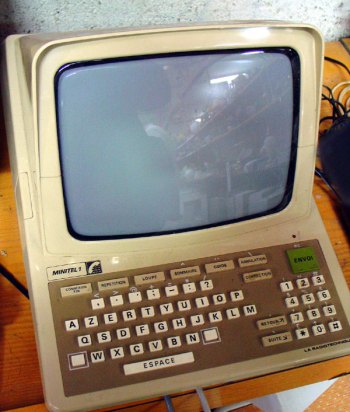By Tristan Nitot (@nitot), Mozilla Europe founder, Open Web Evangelist and blogger, ‘Beyond The Code’
Can HTML5 win against Android and iOS? History tends to repeat itself, and surely there is a lesson from the past that could enable us to better predict the future.
The battle between proprietary platforms and Internet services is a great example of Mahatma Gandhi’s quote:
“First they ignore you, then they laugh at you, then they fight you, then you win”.
Let me explain…
The “good” old days of proprietary networks
My first experience of public networks dates from the late 1980s – early 1990s. At that time, the three main options for those who wanted connectivity were AOL, CompuServe and – for the French – the very famous Minitel (see below). These networks were fascinating to me, because they allowed the discovery of online services and communities.
However there was one problem: these platforms were not compatible between each other. It was impossible to send messages from AOL to Minitel. An AOL subscriber could not access CompuServe forums. All the services were “information silos” segregated from each other. It became clear that technical incompatibilities between the services were putting up walls between users.
It was not until the mid-1990s that the Web began to reach out to the general public, further enhancing the deployment of Internet – a technology that was already 2 decades old – among individual customers. Web from the early days had far fewer features than the private networks – web forums were non-existent, quality content frankly rare and setting up an email address was discouraging. Furthermore, TCP/IP was not always supported on PCs before Windows 95.
Now all this was making the proprietary networks laugh at the Web and Internet’s weaknesses.
However, within a few years, and under pressure from users, proprietary networks had to open up to the Internet. CompuServe began providing email addresses for its users to communicate with Internet users. Later, a “gateway” to the Web was opened to enable web browsing from a CompuServe subscription.
The gates were open…
We had lifted the lid of a Pandora’s Box and nothing would be as ever before. Users began to learn how to make web pages. It must be said that they just had to use “View Source” to see what pages were made of. Since PCs were supplied with text editors, it was easy and fun to learn writing your own “personal home page”. I did not not manage to escape the trend and published Virtual Bob in 1996 (don’t click on the link if you’re allergic to animated GIFs).
At some point in time, proprietary networks became stagnant and the Web was widely adopted. In 1998, AOL bought CompuServe and progressively turned itself into an Internet service provider. CompuServe’s “exclusive” content then got published gradually on the Web. If you look at AOL today, it is almost exclusively a publisher of editorial content on the Web, while its Internet operations are almost non-existent.
It is worth noting that the Web did not look at first like a strong competitor to proprietary networks – it was technically limited, it did not have significant marketing budgets to appeal to consumers and it lacked decent content. Yet it managed to sweep away the proprietary platform owners, despite them having strong technological and financial basis.
And openness changed the rules
So how did such a poorly-funded, technologically-limited contender beat the established players?
At core, its strength was its openness and decentralized nature. Developers were creating new services without having to cut a deal with a central organization. Hobbyists could create content without having to ask permission. Entrepreneurs could become Internet Service Providers. This was combined with free and Open Source Software that allowed everyone to test, tweak, create innovative new services, or create open versions of existing proprietary services. It is the openness of the Internet and the Web that made them successful, pushing the proprietary platforms to close within a few years.
The situation on the mobile
Fast forward to 2013: the major mobile platforms (Apple iOS, Google Android, Microsoft Windows Phone, BlackBerry, etc.) are mutually incompatible. These platforms, led by the iPhone, brought their fair share of innovation.
But history is about to repeat itself with the arrival on mobile of HTML5, an evolution to the Open Web technologies that changed the world 20 years earlier.
Existing mobile platforms are going to need to open up to mobile Web application development. On Android, with Firefox installed, you can already run Web Applications from the Firefox Marketplace. Firefox OS runs them in native mode.
Microsoft Windows Phone and BlackBerry also claim compatibility with applications in HTML5. Even iOS, which at the beginning of the iPhone was a pioneer of Web applications, can no longer ignore this trend, which gives users the ability to create applications without going through the pain of an app store.
All players competing for third place behind Apple and Google are betting on HTML5, realizing that this is their only chance of making it. Developers themselves, tired to develop their applications twice – for Android and the iPhone – have already started developing in HTML5, relying on tools like PhoneGap and Cordova to wrap these HTML5 apps in order to submit them to app stores.
Will Gandhi’s maxim apply to the development of mobile Web applications? I’m willing to bet on it: we have already suffered ignorance and faced the taunts.
Now is the time for the battle, and soon the victory – the victory of the Web on mobile, an Open technology which will give developers and users more control over their digital lives.
You can be part of the adventure by contributing to the Mozilla project.
(main blog image credit: rejon via Flickr)
![[Guest Post] HTML5, AOL and Gandhi](https://en.blogthinkbig.com/wp-content/uploads/sites/5/2013/03/open-web-html5.jpg?resize=610%2C225)









